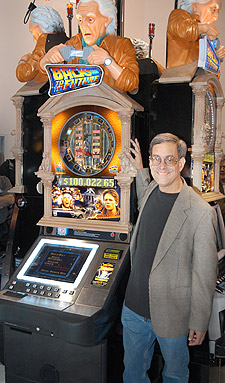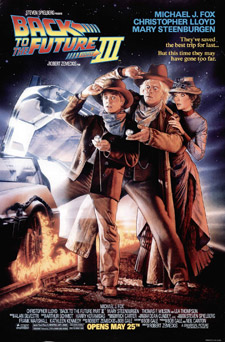
Interview Date: 10/15/2010
Run Date: 10/25/2010
Interviews Home / Movies Home / Bullz-Eye Home
During the late ‘70s and early ‘80s, Bob Gale had a hand in writing and producing a trifecta of films which continue to have cult followings to this day: “I Wanna Hold Your Hand,” “1941,” and “Used Cars.” Those three films are only a minor career blip, however, when compared to his next three: the “Back to the Future” trilogy. It may make you feel old to realize that the first “Future” film was released two and a half decades ago, but the good news is that you’ll find yourself feeling young again as soon as you pop in the “Back to the Future: 25th Anniversary Trilogy” DVD and Blu-ray set, which hits stores on October 26th. Bullz-Eye had a chance to talk to Gale on the occasion of the films’ reissue, and he had plenty to say on their origins, revelations about some of the folks who were originally in consideration for the roles of Marty McFly and Doc Brown, a sequel idea that never came to fruition, and which actors wanted too much money to appear in “Back to the Future III.”
Bullz-Eye: Hey, Bob, good to talk to you!
Bob Gale: How are you?
Bullz-Eye: I’m good, thanks. I just finished going through the trilogy again, and it holds up just as well now as it did 25 years ago.
BG: Thanks, Will! It’s amazing how well, isn’t it? And they look so good now.
BE: They really do. I’ve got a Blu-ray player, and watching it in HD...it’s pretty nuts.
BG: Yeah, I was totally blown away when I took that first pass through the transfer. I went, “Wow!” (Laughs)
Bullz-Eye: So all of your previous films had been more or less set in the real world. What were the origins of your interest in doing a time-travel story? Had you been a sci-fi buff?
BG: Oh, yeah. I mean, both Bob (Zemeckis) and I, we were kids when the George Pal movie (“The Time Machine”) came out in 1960, so that kind of twisted our heads around. And we grew up watching “The Twilight Zone,” which, of course, helped warp our brains. I was a big comic book guy, and through watching “The Twilight Zone,” I discovered Ray Bradbury and became a big science fiction fan. Throughout high school and college, I’m reading Heinlein and Robert Silverberg, so all of this time travel stuff and science fiction stuff…that’s been in my DNA for a long time, and Bob’s as well. We actually were fascinated by how people always predict the future wrong and were always interested in the vision of the future as seen in the 1939 World’s Fair, with the Norman Bel Geddes design and that streamlined modern look, and we always wondered, “Wouldn’t it be cool where we could realize that as the future?” So that was really kind of the very first time-travel idea we ever had together, saying, “How can we make that work?” And we never really…it was an idea. It wasn’t ever a story. And we would go back to it and say, “Well, what if we did a time-travel thing about this and a time-travel thing about that?” And it never really passed what we call “the 24-hour test,” which is where we spitball an idea, get excited about it, talk about it, sleep on it, and 24 hours later, we decide, “Are we still thinking about that, or was that just a party where we got really, really drunk?” So if you’re sober and it still sounds interesting… (Laughs) …then you pursue it. But none of these had any traction until what happened to me in the summer of 1980, when I was visiting my parents and discovered my high school yearbook in the basement. (Hesitates) Do you know the story?
BE: I do, actually.
BG: Well, then, I won’t repeat it. You can just transcribe it from the DVD! (Laughs)
 (Writer’s note: In a nutshell, Gale began flipping through the yearbook and soon discovered that his father had been the president of his class. This led Gale to consider the president of his own high school class, with whom he’d never had any real relationship, and Gale soon found himself wondering if he would’ve been friends with his father if they’d gone to high school together. Upon returning to California, Gale pitched the idea to Zemeckis, and the rest is history.)
(Writer’s note: In a nutshell, Gale began flipping through the yearbook and soon discovered that his father had been the president of his class. This led Gale to consider the president of his own high school class, with whom he’d never had any real relationship, and Gale soon found himself wondering if he would’ve been friends with his father if they’d gone to high school together. Upon returning to California, Gale pitched the idea to Zemeckis, and the rest is history.)
BG: That yearbook was where the light bulb went off, and we started thinking, “Okay, there’s a time travel movie here…” But even in the early drafts, we had the future that Marty returns to…the 1981 that he returns to, because that was the date of the first draft…was this streamlined future that Doc reinvented because of some technology that Marty brought back. And we just couldn’t…we had a hard time letting loose of that idea. Nobody ever liked that. (Laughs) The idea that Marty would end up in this world, even though we thought it was cool, he wouldn’t have. So we threw that idea out and made his family better but kept the world exactly the same.
BE: Of the other actors that had reportedly been in consideration for the role, I can believe that C. Thomas Howell was talked about…
BG: C. Thomas Howell was the other finalist at the time, but John Cusack was somebody we considered. Johnny Depp read for us, believe it or not. I don’t remember the screen test. I mean, I looked through the notes, and I said, “Geez, I don’t even remember that we read Johnny Depp!” So whatever he did, it wasn’t all that memorable, I guess. (Laughs)
BE: Is it true that Corey Hart was briefly in the running?
BG: You know, I don’t think so. I don’t have any memory of that. Somebody said that he was our first choice, but that’s insane.
BE: I think Corey Hart’s the one who said that. (Laughs)
BG: I don’t know where that one came from. I remember John Cusack. I remember…there was a kid named George Newbern who flew out from Chicago for an open casting call who was pretty good, and…he’s on some TV series now. I don’t remember the name of it. But I remember him. But Corey Hart? Nope. Don’t think so.
BE: I actually could have seen John Lithgow as Doc Brown.
BG: Well, again, that was just kind of in passing. The only other guy we really seriously considered for Doc Brown was Jeff Goldblum. And you can see him, too, right?
BE: Absolutely
BG: Yeah, Jeff came in, and…I’m certain we talked about John Lithgow, but I don’t remember if he actually ever came in, if we met him. But I vividly remember meeting Jeff and liking him for it.
BE: Is it true that Tony Hawk helped with the skateboard training?
BG: (Starts to laugh) Okay, uh…
BE: I’m just confirming or denying all of these rumors.
BG:No, okay, I appreciate that. It’s funny because I was just talking about it in the last interview.
Publicist: I’ve got the date, if you want it.
BG: I just looked it up myself, actually…
Publicist: (Laughs) Okay!
BG: …and Tony Hawk was born in 1968, so when we were making the movie, he would’ve been 16 years old. There’s no possibility that could have happened. That’s one of the stupidest rumors that anybody with the internet can look up and say, “Yeah, how could he have done that?”
BE: In my defense, I always take any fact I read on Wikipedia with a grain of salt.
BG: (Laughs) Well, the credited skateboard guys are Per Welinder and Bobby Schmelzer, and it’s kind of a funny story about how they ended up getting hired. We were in pre-production on the movie, and one Sunday my soon-to-be-wife and I were walking down Venice Boardwalk, and there were these skateboarders doing some skateboard demonstrations and stunts. Now, you have to remember, back then, skateboarding was not as big a deal as it has since become, and Bob and I were trying to figure out, “Where are we going to find skateboarders?” So I saw these guys, and I said, “Shit, this is great! These guys are good! We need these guys!” So I went up to them, and I said, “Look, I know this is going to sound like I’m giving you a line or something, but I’m producing a movie, and would you guys be interested in being involved with it?” Well, they turned around and gave me their business cards…and they had agents! (Laughs)
BE: (Laughs) Welcome to L.A.! So did you ever hear from John DeLorean about the use of his car as a time machine?
BG: Oh, yeah! The best fan letter we ever got was from John DeLorean! He loved the movie, and he wrote a wonderfully nice fan letter. We talk about that in the new documentary, and I think it’s reproduced in there, but he said, “Thank you for keeping my dream alive,” or something like that. He was very, very laudatory, and he said that Ron Cobb, Andrew Proberg, Kevin Pike, and Michael Scheffe, who were the four guys who really designed the car, “They can join my next design team anytime.”
BE: Were there ever any sequel ideas that existed on the drawing board prior to the development of the ones you went with? I’ve heard there were talks of going to 1967 instead of 1955.
BG: Yeah, well, actually, there was a script written with that in it. Instead of going back into the first movie in the third act, they go back to 1967, Old Biff gives the Sports Almanac to his younger self there, and by Marty going there, he interferes… he gets involved in some anti-war protest, he gets thrown in jail, Lorraine gets thrown in jail, and because of that, George and Lorraine are not going to show up at the Mark Hopkins Hotel on the night that Marty’s to be conceived. So Marty has to get his parents to show up at the hotel so that he can be born. (Laughs) I wrote a whole draft of that, and Bob was off making “Who Framed Roger Rabbit,” but he read it, and he said, “Well, you know, didn’t we really kind of already do this? Do we need to do this again?” And he said, “We can do something in the sequel that’s never been done before! We can use the time machine to go back into the first movie and see it from a different point of view!” And that was just such a visionary idea that I was, like, “Yeah! That’s brilliant! Let’s do that!” So that’s how that came about. I had to write the wrong version to get the right version.
BE: When you did “Back to the Future III,” did you guys just have a wish list of old-time Western actors that you wanted to have appear?
BG: Oh, yeah.
BE: Was there anybody who couldn’t or didn’t want to be in it?
 BG: Yeah, we wanted to get Ben Johnson in it, but he wanted a quarter of a million dollars. And we were, like, “No, that’s not happening.” (Laughs) And…who else did we consider? Richard Farnsworth. Is that his name? The guy from “The Grey Fox”? Yeah, he wanted too much money as well. But Harry Carey, Jr., he was always one of the top guys we wanted, and he was great. They were all great. We had worked with Dub Taylor before in “Used Cars,” so we knew Dub, and Pat Buttram, of course, that voice. But Harry Carey, Jr. has a photographic memory, so between takes we asked him about John Ford movies and stuff, and he’d just tell these great stories from “Three Godfathers,” “The Searchers,” and all this stuff. It was great.
BG: Yeah, we wanted to get Ben Johnson in it, but he wanted a quarter of a million dollars. And we were, like, “No, that’s not happening.” (Laughs) And…who else did we consider? Richard Farnsworth. Is that his name? The guy from “The Grey Fox”? Yeah, he wanted too much money as well. But Harry Carey, Jr., he was always one of the top guys we wanted, and he was great. They were all great. We had worked with Dub Taylor before in “Used Cars,” so we knew Dub, and Pat Buttram, of course, that voice. But Harry Carey, Jr. has a photographic memory, so between takes we asked him about John Ford movies and stuff, and he’d just tell these great stories from “Three Godfathers,” “The Searchers,” and all this stuff. It was great.
BE: And lastly…and I ask this not to be controversial but, rather, because it actually came up in an interview that we did, but…we talked to Crispin Glover a few months ago, and when the topic of the sequels came up, he got very upset and said that you had accused him of asking for twice the money that Michael J. Fox did.
BG: No, I didn’t ever accuse him of that. If you watch the commentaries and everything, I’ve never accused him of that. He asked for the same deal that Michael was getting, which was still ridiculous. He wanted what in film talk is called “favored nations.” It’s where what one actor gets another actor gets. His agent said that’s what he wanted, and I said, “C’mon, Elaine…” Elaine Goldsmith was his agent’s name. I said, “You know that’s not going to fly. I’m not even going to respond to that. Go back to your client, talk to him, come up with something that’s reasonable.” And she couldn’t get him to budge. Well, then, Crispin, as “Part II” got into pre-production, people started telling him, “Are you insane, pal? You’re not doing it?” Now, remember, we’d written the whole script figuring we didn’t have George McFly. So Crispin came back, and he said, “Okay, let’s talk.” And he read the script, he walked around on the future sets with Bob Zemeckis. He walked around the backlot with Bob, and we thought he was going to do it. And we would have used him in the future scene, but, again, he started asking for more money than…he wanted to get the same amount that Tom Wilson (Biff) was going to get. But Tom Wilson was going to be in the movie for 13 weeks, and Crispin was going to be in the movie for 5 weeks. Neither Bob nor I…we said, “We can’t pay Crispin for five weeks of work for the same money that Tom Wilson’s getting for 13. That’s just not right. Crispin isn’t a bigger name than Tom Wilson.” Not in 1989 he wasn’t. So I said, “We’ll give Crispin the same weekly that Tom’s getting, and that’ll be fair.” And he said “no.” I know it’s a sore spot with him, and, look, I’m sorry Crispin didn’t do it, but I don’t bear him any malice or anything. And, hey, he’s gone back and been in “Beowulf” for Bob Zemeckis, so they’ve made their peace. So if he wants to think of me as the bad guy, that’s fine. That’s what producers get paid to be. (Laughs)
BE: Fair enough. Well, Bob, it’s been a pleasure talking to you, but I’ve got one more to close with. Which do you think is going to come first: flying cars or the Cubs winning the World Series?
BG: (Bursts out laughing) That is a very good question. You get the award, because nobody’s asked me that question in exactly that way. Um…I think flying cars are coming first. (Laughs) Actually, if you go on YouTube or if you Google “flying cars,” somebody’s got one. Somebody’s got a new one that looks…I mean, they keep somebody’s going to make it, but this one’s pretty cool. They’ve got footage of it flying and turning into a car and stuff, with the wings folding up. It’s interesting. So I would say, yeah, flying cars before the Cubs.
BE: Excellent. Thanks again, Bob!
BG: You’re welcome!
You can follow us on Twitter and Facebook for content updates. Also, sign up for our email list for weekly updates and check us out on Google+ as well.











